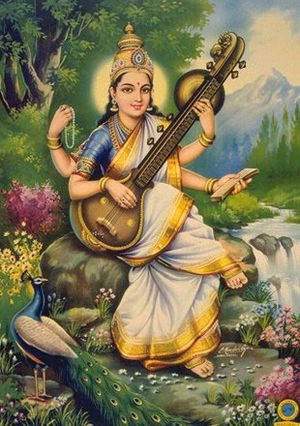Sarasvati

The Divine Mother in her manifestation as Sarasvati is the shakti of Brahma. Brahma is known as the Creator in the Hindu Trinity and is parallel to God the Father in the Western Trinity. He is the Divine Lawgiver, the source of all knowledge. Together, Brahma and Sarasvati are the embodiment of cosmic force.
Sarasvati is known as the Goddess of the Word. She is identified with Vac, the Word. She represents eloquence and articulates the wisdom of the Law. She is the Mother-Teacher to those of us who love the Law revealed by Brahma, and she is the power of volition, the will and motivation to be the Law in action. Sarasvati represents the union of power and intelligence from which organized creation arises.
Sarasvati is sometimes represented with four hands, sitting on a lotus. She holds the sacred scriptures in one hand and a lotus in another. With the remaining two hands, she plays the Indian lute (veena). She is called the Flowing One, the source of creation by the Word. Sarasvati also represents purity and wears white. Her transcendent nature is suggested in her vehicle, the swan, which is a symbol of spiritual transcendence and perfection.
Sarasvati is associated with speech, poetry, music and culture and is known as the Goddess of Learning and the Patroness of the Arts and Music. She is revered by both Hindus and Buddhists. To Buddhists, she is the consort of Manjushri, the bodhisattva of wisdom. Buddhists appeal to Manjushri for intelligence, wisdom, mastery of the teaching, the power of exposition, eloquence and memory. He works with Lord Maitreya. The two are sometimes depicted in a triad with Gautama Buddha in which Manjushri represents the wisdom aspect and Maitreya the compassion aspect of Buddhist teaching. Like Sarasvati, Manjushri brings the gift of illumination.
In the earliest Hindu texts, the Vedas, Sarasvati is a river goddess. The Vedas say that Sarasvati was the greatest river in India. For years the Sarasvati was believed to have been a myth, but an archaeological survey in 1985 found an ancient riverbed that matched the description of the Sarasvati. It was a great river, four to six miles wide for much of its length. It flowed westward from the Himalayas into the sea.
The Rigveda calls Sarasvati “the best mother, the best river, [and] the best Goddess.”[1] It also says, “Sarasvati like a great ocean appears with her ray, she rules all inspirations.”
Her sacred “seed syllable,” or bija, is Aim (pronounced ah-eem). A bija mantra encapsulates the essence of a cosmic being, of a principle or a chakra. Sarasvati’s mantra is Om Aim Sarasvatye Namaha.
See also
Sources
Mark L. Prophet and Elizabeth Clare Prophet, The Masters and Their Retreats, s.v. “Sarasvati, Shakti of Brahma.”
- ↑ Rigveda 2.41.16, 1.3.12, quoted in David Frawley, Gods, Sages and Kings: Vedic Secrets of Ancient Civilization (Salt Lake City, Utah: Passage Press, 1991), pp. 70, 71.
